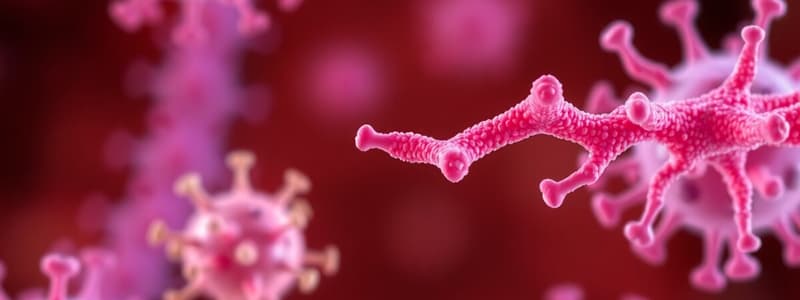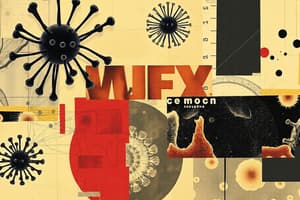Podcast
Questions and Answers
Antigenicity refers to the property of remaining inert when exposed to an immune system.
Antigenicity refers to the property of remaining inert when exposed to an immune system.
False (B)
Epitopes are large molecular groups recognized by lymphocytes.
Epitopes are large molecular groups recognized by lymphocytes.
False (B)
Antigens that activate T-cell lymphocytes are typically protein-based.
Antigens that activate T-cell lymphocytes are typically protein-based.
True (A)
Immunocompetence refers to the reduced ability of the body to interact with a wide spectrum of foreign substances, such as antigens.
Immunocompetence refers to the reduced ability of the body to interact with a wide spectrum of foreign substances, such as antigens.
The adaptive immune system only responds to general features on pathogens.
The adaptive immune system only responds to general features on pathogens.
The adaptive immune system creates memory cells for weaker future responses.
The adaptive immune system creates memory cells for weaker future responses.
During the processing of bacterial antigens, the bacterium is phagocytosed into a dendritic cell and encased in a peroxisome.
During the processing of bacterial antigens, the bacterium is phagocytosed into a dendritic cell and encased in a peroxisome.
In the processing of viral antigens, the antigens are loaded onto a Major Histocompatibility Complex (MHC-I) protein cup.
In the processing of viral antigens, the antigens are loaded onto a Major Histocompatibility Complex (MHC-I) protein cup.
Major Histocompatibility Complex class I (MHC-I) molecules are found on the surface of the types of white blood cells.
Major Histocompatibility Complex class I (MHC-I) molecules are found on the surface of the types of white blood cells.
Macrophages transform into monocytes when activated.
Macrophages transform into monocytes when activated.
T cells connect with the innate cell containing the antigen to become activated.
T cells connect with the innate cell containing the antigen to become activated.
T cell receptors are formed by genetic recombination, similar to B cell receptors, and they are released into the blood.
T cell receptors are formed by genetic recombination, similar to B cell receptors, and they are released into the blood.
The T helper (Tₕ) cells (also called CD4 cells) express CD4 receptors and are activated by antigen/MHC-I.
The T helper (Tₕ) cells (also called CD4 cells) express CD4 receptors and are activated by antigen/MHC-I.
Memory cells are never produced to allow stronger and faster immune responses.
Memory cells are never produced to allow stronger and faster immune responses.
A T-cell takes the antigen from the APC and holds it on its B-cell receptor.
A T-cell takes the antigen from the APC and holds it on its B-cell receptor.
In B-Cell Activation, the T cell gives off additional signals in the form of interleukins and dendritic growth factors.
In B-Cell Activation, the T cell gives off additional signals in the form of interleukins and dendritic growth factors.
Antibodies have specificity, meaning the two Fab sites are slightly different for each antigen.
Antibodies have specificity, meaning the two Fab sites are slightly different for each antigen.
The Fc fragment of an antibody binds to cell membranes and may cause release of cytokines.
The Fc fragment of an antibody binds to cell membranes and may cause release of cytokines.
IgE is primarily involved in responses to exotoxins and parasitic fungal infections.
IgE is primarily involved in responses to exotoxins and parasitic fungal infections.
Neutralization is the process of coating microorganisms with specific antibodies so they are more readily recognized by phagocytes.
Neutralization is the process of coating microorganisms with specific antibodies so they are more readily recognized by phagocytes.
Opsonization enhances phagocytosis because antibodies act as a kind of molecular flag, alerting phagocytes to the presence of the pathogen.
Opsonization enhances phagocytosis because antibodies act as a kind of molecular flag, alerting phagocytes to the presence of the pathogen.
The immune genes are not recombined randomly to make new T-cell and B-cell receptors.
The immune genes are not recombined randomly to make new T-cell and B-cell receptors.
An undifferentiated lymphocyte has about 50 genes that code for the variable region of light chains.
An undifferentiated lymphocyte has about 50 genes that code for the variable region of light chains.
T cell receptors remain on the cell membrane.
T cell receptors remain on the cell membrane.
B cell receptors are permanently attached.
B cell receptors are permanently attached.
Clonal selection happens if a recombinant-receptor carrying cells do not come into contact with a microbe containing antigens.
Clonal selection happens if a recombinant-receptor carrying cells do not come into contact with a microbe containing antigens.
If the T-cell receptor does not matches, the innate cell automatically activated.
If the T-cell receptor does not matches, the innate cell automatically activated.
T helper cells can helps cytotoxic T cells and B cells in their immune functions.
T helper cells can helps cytotoxic T cells and B cells in their immune functions.
The activation of a B cell only has one fate: the production of effector cells.
The activation of a B cell only has one fate: the production of effector cells.
A primary response is when a latent period is lacking because other memory lymphocytes from the earlier response are immediately ready to react.
A primary response is when a latent period is lacking because other memory lymphocytes from the earlier response are immediately ready to react.
The first antiboy to appear upon first exposure has a highter presence of IgM.
The first antiboy to appear upon first exposure has a highter presence of IgM.
Natural killer cells recognize specific antigens on target cells.
Natural killer cells recognize specific antigens on target cells.
Alloantigens are cell surface markers that occur in all members of the same species.
Alloantigens are cell surface markers that occur in all members of the same species.
Blood type is not a potential alloantigen.
Blood type is not a potential alloantigen.
Superantigens provoke tailored responses by select groups of T cells based on their specific antigen recognition.
Superantigens provoke tailored responses by select groups of T cells based on their specific antigen recognition.
The adaptive immune response includes generalized responses that recognize general features on a pathogen.
The adaptive immune response includes generalized responses that recognize general features on a pathogen.
T helper cells are classified as CD8.
T helper cells are classified as CD8.
B cells require activation from T helper cells.
B cells require activation from T helper cells.
Cytokines tell cells what to do in the immune response.
Cytokines tell cells what to do in the immune response.
Natural Killer cells directly use antibodies to tag infected cells.
Natural Killer cells directly use antibodies to tag infected cells.
The innate immune system recognizes general features common to a pathogen.
The innate immune system recognizes general features common to a pathogen.
Antigens that activate T-cell lymphocytes are generally lipid-based.
Antigens that activate T-cell lymphocytes are generally lipid-based.
Immunodeficiency refers to the body's ability to interact with a wide spectrum of foreign substances.
Immunodeficiency refers to the body's ability to interact with a wide spectrum of foreign substances.
The adaptive immune system connects with the innate immune system.
The adaptive immune system connects with the innate immune system.
During bacterial antigen processing, the bacterium is engulfed via endocytosis.
During bacterial antigen processing, the bacterium is engulfed via endocytosis.
MHC class I molecules are presented on antigen presenting cells that have engulfed a microbe.
MHC class I molecules are presented on antigen presenting cells that have engulfed a microbe.
The primary role of T helper cells is to directly kill infected cells.
The primary role of T helper cells is to directly kill infected cells.
Cytotoxic T cells express CD4 receptors and are activated by antigen presented on MHC class II molecules.
Cytotoxic T cells express CD4 receptors and are activated by antigen presented on MHC class II molecules.
The main function of B cells is to perform phagocytosis of pathogens.
The main function of B cells is to perform phagocytosis of pathogens.
In T-cell independent B-cell activation, the B-cell requires signals from a T helper cell to become activated.
In T-cell independent B-cell activation, the B-cell requires signals from a T helper cell to become activated.
During clonal selection, lymphocytes that bind to self molecules are stimulated to proliferate.
During clonal selection, lymphocytes that bind to self molecules are stimulated to proliferate.
Immunoglobulins are composed of six polypeptide chains in a Y-shaped arrangement.
Immunoglobulins are composed of six polypeptide chains in a Y-shaped arrangement.
During a secondary immune response, there is a long latent period before antibody production begins.
During a secondary immune response, there is a long latent period before antibody production begins.
Alloantigens are cell surface markers that occur in some, but not all, members of the same species
Alloantigens are cell surface markers that occur in some, but not all, members of the same species
Flashcards
Immunocompetence
Immunocompetence
Ability of the body to interact with a wide spectrum of foreign substances (antigens).
Immunodeficiency
Immunodeficiency
Having a compromised or weakened immune system.
Antigen (Ag)
Antigen (Ag)
Substance that elicits an immune response in specific lymphocytes.
Antigenicity
Antigenicity
Signup and view all the flashcards
Epitopes
Epitopes
Signup and view all the flashcards
Innate Immune Response
Innate Immune Response
Signup and view all the flashcards
Adaptive Immune Response
Adaptive Immune Response
Signup and view all the flashcards
Antigen Presentation
Antigen Presentation
Signup and view all the flashcards
Cytotoxic T cells (Tc)
Cytotoxic T cells (Tc)
Signup and view all the flashcards
T Helper (TH) Cells
T Helper (TH) Cells
Signup and view all the flashcards
B Cells
B Cells
Signup and view all the flashcards
Antibodies
Antibodies
Signup and view all the flashcards
Immunoglobulins
Immunoglobulins
Signup and view all the flashcards
Opsonization
Opsonization
Signup and view all the flashcards
Neutralization
Neutralization
Signup and view all the flashcards
Natural Killer Cells (NK)
Natural Killer Cells (NK)
Signup and view all the flashcards
Alloantigens
Alloantigens
Signup and view all the flashcards
Superantigens
Superantigens
Signup and view all the flashcards
Cytokines
Cytokines
Signup and view all the flashcards
Primary Response
Primary Response
Signup and view all the flashcards
Secondary Response
Secondary Response
Signup and view all the flashcards
Antigens
Antigens
Signup and view all the flashcards
Study Notes
Innate vs. Adaptive Immunity
- The innate immune system has a generalized response, recognizing general pathogen features.
- A stronger immune response can recognize specific parts of a pathogen for invader identification.
- These specific parts are called antigens, each possessing multiple epitopes.
Antigens and Epitopes
- An antigen (Ag) is a substance triggering an immune response in specific lymphocytes.
- Antigenicity is the property of behaving as an antigen.
- Factors such as foreignness, size, shape, and accessibility contribute to antigenicity.
- Antigens have antigenic determinants also known as epitopes, and they are small molecular groups recognized by lymphocytes.
Molecular Shape, Size, and Antigenicity
- T-cell lymphocytes are activated by protein-based antigens.
- B-cell lymphocytes are activated by protein, sugar, fats, etc. antigens.
Antigen Presentation
- Adaptive Immune System functions include specific responses to epitopes, connection with the innate immune system, continuous antigen processing, T-cell control over immune responses against specific microbes, B-cell antibody production, and creation of memory cells for an enhanced future response.
- Adaptive Immune Response is also known as the Acquired Immune Response.
Processing Bacterial Antigens
- Bacteria gets phagocytosed by a cell like a dendritic cell or macrophage, then it enters a vacuole.
- Lysosomes fuse with vacuole, using acids and enzymes to destroy bacteria.
- Antigens from the bacteria are added to individual Major Histocompatibility Complex II (MHCII) protein "cups."
- The "cups" with antigens move to the cell surface for presentation to the immune system.
Processing Viral Antigens
- A virus growing inside an infected cell uses the host's machinery to make proteins.
- The host cell takes some of these viral proteins and destroys them, separating the viral antigens.
- Antigens are loaded onto a Major Histocompatibility Complex (MHC-I) protein cup.
- The MHC-I "cup" with the antigen moves to the cell surface and is presented.
- All cells except red blood cells have an MHC-I system.
Antigen Presenting Cells
- Dendritic cells contain both MHC-1 and MHC-2.
- Macrophages start as monocytes, transform when activated, and are the main APC contributor.
Lymphocytes
- Lymphocytes, including T and B cells, are the main cells involved in acquired immunity.
T-Cells
- Overall specific immunity is controlled by T-cells by communicating with various cell types. This communication turns cells on, expresses genes, and other functions.
- T-cells are turned on by connecting with the innate cell containing the antigen on its surface.
- Memory cells are created during the first infection, allowing stronger, faster subsequent responses to recurring pathogens.
Activating T-cells
- Innate cells (phagocytes, macrophages, dendritic cells) digest and present various epitopes from an antigen on their surfaces using specific receptors called Major Histocompatibility Complex (MHC).
- Each T-cell has a specific receptor with a specific shape that fits a specific epitope on an antigen.
- The T-cell produces specific cytokines for certain immune responses if the receptor matches.
- An activated T-cell multiplies to create more specific cells and its receptors.
- The activated T-cell makes memory cells for later use.
T-Cell Receptors
- T-cell receptors are formed by genetic recombination, like B cell receptors with constant and variable regions.
- Receptors have 2 parallel polypeptide chains.
- Unlike B-cell receptors, T cell receptors are small, and remain intact on the T cell's surface.
Cytotoxic T-Cells
- Cytotoxic T (TC) cells also known as CD8 cells express CD8 receptors and are activated by antigen/MHC-I.
- They destroy foreign or abnormal cells by secreting perforins and granzymes.
- They destroy transplanted cells and organs.
Helper T-Cells
- T Helper (TH) cells, also known as CD4 cells, express CD4 receptors and are activated by antigen/MHC-II.
- They are the most prevalent type of T cell in blood and lymphoid organs.
- They regulate the immune reaction to antigens, including other T and B cells.
- They are involved in activating macrophages and increasing phagocytosis.
Types of T-cells and Functions
- T helper cells (TH) use CD4, TCR to activate other CD4 and CD8 cells; secrete cytokines and interferon gamma; control immune response with cytokines and MHC-II receptors; activate B cells.
- T cytotoxic cells (TC) use CD8, TCR to destroy a target foreign cell by lysis, are important for the destruction of cancer cells and virus-infected cells, and graft rejection; requires MHC I for function.
B-Cells
- B-cells produce antibodies when activated using innate immune cells, antigens on their surface with specific receptors, and T-cells that carry antigens on their surface.
- Memory cells are produced to allow stronger and faster immune responses
Activation of B-cells
- The B-cell's receptor connects with the antigen on the microbe directly.
- If the antigen fits, the B-cell becomes activated.
- The B-cell receptor becomes an immunoglobulin, also known as an antibody; released into the blood to provide humoral immunity.
- The activated B-cell makes copies of itself which are stored as memory cells.
B-Cell T-Cell Dependent Activation
- A T-cell takes antigens from the APC and holds it on a T-cell receptor.
- This T-cell attaches to the B-cell through its receptor to find a match to its receptor.
- The B-cell is activated if it matches which turns B-cell receptors into antibodies, allowing expansion of cell amounts, and creation of memory cells.
Immunoglobulins
- Immunoglobulins are glycoproteins acting like B cells receptors and antibodies.
- It is composed of 4 polypeptide chains with 2 identical heavy chains (H) and 2 identical light chains (L) in a Y-shape.
- A wide range of variable antigen-binding sites are located at the ends of the forks caused by the chains which is caused by the V regions.
- Constant (C) regions do not vary greatly.
Fab Antigen-binding Site
- The antigen-binding site is composed of hypervariable regions with an extremely variable amino acid content.
- The groove has a specific three-dimensional fit for the antigen.
- Specificity of Fab sites is identical for each antigen.
Fc Fragment Function
- The Fc fragment binds to cell membranes of macrophages, neutrophils, eosinophils, mast cells, basophils, and lymphocytes where regions on the Fc portion in certain antibodies fix complements.
- Binding of Fc may cause the release of cytokines.
Classes of Immunoglobulins
- IgG is a monomer produced by plasma cells, crosses placenta, and is most prevalent.
- IgA is a monomer that circulates in the blood and a dimer in mucous and serous secretions.
- IgM contains five monomers and is the first class synthesized following Ag encounter.
- IgD is a monomer acting as a receptor for antigens for B cells.
- IgE is used in allergic responses and parasitic worm infections.
- The differences in these classes are due primarily to variations in the Fc.
Antibody-Antigen Interactions
- Antibodies unite with, immobilize, call attention to, or neutralize the Ag for which it was formed.
- Opsonization is the coating microorganisms or particles with specific antibodies which causes microorganism recognition with a phagocyte; carried out by opsonins.
- Neutralization is when antibodies fill the surface receptors and activate a microbial protein or toxin to prevent interaction or attachment.
T-Cell and B-Cell Receptor Creation
- Immune genes during recombination are randomly recombined to make new T-cell and B-cell receptors (and antibodies); each new recombinant has a different shape to recognize specific antigens.
- Lymphocytes use 500 genes to produce a tremendous specificity.
Genetic Composition of Lymphocytes
- Lymphocyte specificity is genetically preprogrammed, even before an antigen enters the system
- Clone – Each genetically different type of lymphocyte expresses a single specificity
- Undifferentiated lymphocytes contain 150 genes for variable light chains, and 250+ genes for the variable(V) and diversity (D) regions of heavy chains.
- Only a small number of genes code for the constant (C) regions and the joining (J) regions that link segments of the final molecule.
Clonal Selection
- During clonal selection, receptors carrying cells come into contact with a microbe containing antigens, the receptor touches the antigen to see if it fits
- The cell makes copies of itself if there is a match.
- The cell will it let other cell receptors touch if there is not a match until a match is made
- If the receptors recognize a self molecule, the cells are eliminated
Cytokines
- Cytokines are proteins immune cells release, that bind to other immune cells and other cells, and tell them what to do in response to infection.
Monitoring Antibody Production Over Time
- Primary response is a latent period where the IgM antibody occurs early, followed by the IgG activation. then the titer tapers back to low levels.
- Secondary response is a latent period that lacks when lymphocytes respond rapidly which causes a rapid increase in antibody levels.
Natural Killer Cells
- NK cells release perforins, which polymerize, and form a hole in a foreign cell membrane to degrade proteins.
- The foreign cell will die through apoptosis
- The macrophage will engulf and digest the dying cell
Antigen Recall
- Antigens are molecules that stimulate an immune response such as epitopes.
The types of Antigens
- Alloantigens are markers and molecules that occur in some members of the species, for example, blood groups and major histocompatibility profiles.
- Allergens are a type that produces vigorous immune responses where perceived threats by the immune system fight a harmless body
Characteristics of Superantigens
- Superantigens are viral/bacterial virility factors that provoke overwhelming immune responses by a large amount of T cells
- Cytokine releases
- Blood Vessel damage
- Toxic shock
- Multi-Organ Failure
Studying That Suits You
Use AI to generate personalized quizzes and flashcards to suit your learning preferences.




